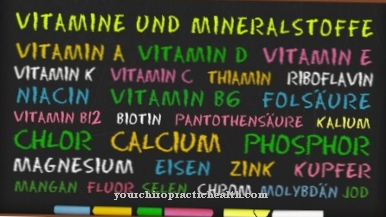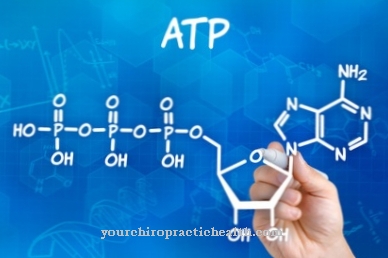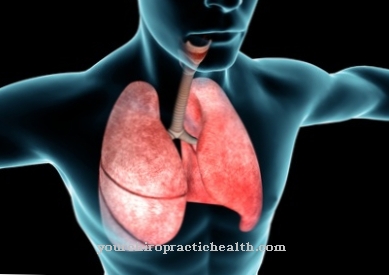The apocrine secretion corresponds to secretion release in vesicles. This mode of secretion is relatively rare and occurs mainly in the apical sweat glands. In the case of a sweat gland abscess, the affected skin regions are inflamed and trigger fistula formation.
What is the apocrine secretion?

In medicine, the expression "secretion" means the release of a secretion. Glands and gland-like cells are either exocrine or endocrine. In the case of the endocrine glands, secretion takes place via outlet ducts. In exocrine glands, the secretion does not take place via channels, but the secretion is released to the body surface or into a body cavity.
Exocrine secretion can take place in a number of ways. In this context, the secretion modes of exocrine glands are also mentioned. Apocrine secretion is one of three modes of secretion that exocrine glands and gland-like cells pursue in the human organism. The gland cell constricts the secretion from part of its cell membrane, which, together with the apical cytoplasm in the immediate vicinity, forms individual vesicles and is consumed in this process.
The eccrine and holocrine modes are to be distinguished from this rather seldom occurring mode. Apical modes, in turn, are mainly found in the mammary glands and in the prostate or seminal vesicle. The scent glands of the human skin also follow the apocrine mode.
Function & task
Secretions perform many different tasks in the human body. Endocrine secretions, for example, are hormonally active and influence the control of various body processes. Exocrine secretions in the apocrine mode have a particular function as sex secretions.
For example, the man's seminal vesicle produces a protein. This protein is known as semenogelin and it locks the sperm in a matrix of gel. This protects the seeds and prevents premature decay. In this way, the secretion of the seminal vesicle ultimately ensures the continued existence of humans by supporting reproduction. It is released in part by eccrine exocytosis and to a certain extent by apocrine processes.
Apocrine secretion is a release in secretory vesicles. These vesicles correspond to fat droplets that collect in the cell membrane of the gland cells towards the lumen. Compared to eccrine glands, apocrine glands have an additional lumen and have tiny protuberances of the apical cell membrane at the cell pole. The accumulated fat droplets do not fuse with the gland cells, but remain separate. The ready-to-dispense drops finally bind to the hem of integral membrane proteins, such as those found in the cell membrane as butyrophilin. This bond causes the fat droplets to curve continuously into the lumen of the gland. The membrane of the gland cell gradually contracts below this bulge. So not only the fat pot is pinched off, but also the surrounding cytoplasm and the attached cell membrane on the outside of the cell. The secretion is packed in membrane containers.
This process is also known as apocytosis and causes the gland cells to lose their cytoplasm and cell membrane. The volume of the cells decreases as a result of this process, which distinguishes the secretion mode from eccrine secretion. The secretion is only released from the cell when the former cell membrane ruptures.
In addition to the seminal vesicle, the mammary gland carries out apocrine secretion. This secretion corresponds primarily to the release of fat from the breast epithelial cells. In addition, the minor glands of the eyelid also follow this mode of secretion, which are to be understood as sweat-like apocrine glands of the lid margin.
Apocrine sweat glands are also found under the armpits, genital area and anus, and on the nipples. These glands are actually scent glands that release pheromones and thus to a certain extent influence sexual behavior.
You can find your medication here
➔ Drugs against sweating and sweatingIllnesses & ailments
Especially with the secretion by the apocrine scent glands of women, strong fluctuations can occur, which as a rule have no disease value, but are more or less dependent on the cycle. Since the scent glands produce a greasy secretion, they are particularly prone to infections. Such infections can disrupt the local protective coating of the acid. If, in turn, the alkaline protective layer is disturbed, the affected area becomes more susceptible to bacterial infections. Therefore, infections often occur in the scent glands, which are usually noticeable in the form of abscesses. In this context, there is also talk of a sweat gland abscess. Such abscesses are accompanied by inflammation and fistula formation.
This disease is sometimes referred to as acne inversa, which mainly affects people in puberty. The apocrine sweat glands only become inflamed secondarily. Originally, the inflammation originates from the holocrine sebum glands in these areas of the skin. Acne inversa is extremely painful. Extensive phlegmon can develop in the connective tissue under the skin, which cause a bluish discoloration and can even lead to sepsis over larger areas.
Since the apocrine sweat glands are primarily responsible for personal body odor, they can also be affected by bromhidrosis. With this phenomenon, an excessively strong body odor occurs due to an increase in the local bacterial flora. The body odor arises from the metabolism of the sebum secretion by the body's own bacteria and thus increases above all when increased sweat penetrates the horny layer of the skin and thus promotes bacterial growth.
Various illnesses, but also psychological stress, can be the cause of the increased sweat production. The apical glands of the breast and the prostate, on the other hand, are often involved in benign and malignant tumor diseases.









.jpg)



.jpg)



.jpg)







.jpg)


